User:Draco ignoramus sophomoricus/sandbox campanian alt
During the Campanian age, a radiation among dinosaur species occurred. In North America, for example, the number of known dinosaur genera rises from 4 at the base of the Campanian to 48 in the upper part. This development is sometimes referred to as the "Campanian Explosion". However, it is not yet clear if the event is artificial, i.e. the low number of genera in the lower Campanian can be caused by a lower preservation chance for fossils in deposits of that age. The generally warm climates and large continental area covered in shallow sea during the Campanian probably favoured the dinosaurs. In the following Maastrichtian stage, the number of North American dinosaur genera found is 30% less than in the upper Campanian.[1]
Animals that lived in the Campanian include:
Cartilaginous fish
[edit]| Cartilaginous fish of the Campanian | ||||
|---|---|---|---|---|
| Taxa | Presence | Location | Description | Images |
 | ||||
Actinopterygii
[edit]| Ray-finned fish of the Campanian | ||||
|---|---|---|---|---|
| Taxa | Presence | Location | Description | Images |
| 100–66 Ma | North America | A genus of osteoglossomorph fish in the family Ichthyodectidae. Unlike its larger relative, Xiphactinus, by which it was preyed upon, it was a filter feeder instead of a large prey predator. |
  
| |
| Coniacian to Campanian | North America | A genus of large osteoglossomorph fish in the family Ichthyodectidae. Like its larger close relative Xiphactinus was a voracious predator. | ||
| Albian to Maastrichtian | North America; Europe; Australia; Venezuela | A genus of large osteoglossomorph fish in the family Ichthyodectidae that could reach up to 4 meters in length. Xiphactinus was a voracious predator. | ||
Actinistia
[edit]| Coelacanths of the Campanian | ||||
|---|---|---|---|---|
| Taxa | Presence | Location | Description | Images |
|
Lower Campanian possibly to early Maastrichtian | France | A species of averagely sized mawsoniid coelacanth. Related species of the same genus lived mostly on earlier stages of the Cretaceous. |
 |
|
Lower Campanian possibly to early Maastrichtian | USA | A very large latimerid coelacanth. It has been estimated to have been 3.5 - 4.5 meters in length.
| |
Dipnoi
[edit]| Lungfish of the Campanian | ||||
|---|---|---|---|---|
| Taxa | Presence | Location | Description | Images |
| Olenekian-Eocene | Cosmpopolitan | A widespread genus of ceratodontiform lungfish in the family Ceratodontidae with multiple species throughout the mesozoic. |
  | |
| Campanian to Recent | Egypt, Sudan | A ceratodontiform lungfish in the family Protopteridae. Species of this genus, survive to this day.
| ||
| Albian–Maastrichtian | Egypt, Sudan | A genus of large ceratodontiform lungfish in the family Ceratodontidae.
| ||
Lepidosaurs
[edit]| Lepidosaurs of the Campanian | ||||
|---|---|---|---|---|
| Taxa | Presence | Location | Description | Images |
|
An agamid iguanian lizard. |
              | ||
|
A varanoid lizard of disputed affinity. | |||
|
A genus of fossil snakes in the extinct family of Madtsoiidae. | |||
| Djadochta Formation, Gobi Desert, Mongolia | An iguanian lizard in the extinct clade Gobiguania. Compared to other iguanians, Anchaurosaurus has a relatively elongated skull, large eye sockets, and higher tooth crowns. | |||
| Brewster County, Aguja Formation, Texas, USA | A scincomorph. | |||
| A genus of anguimorph lizard distantly related to the living Gila monster. | ||||
| 84.9-70.6 mya | Bayan Mandahu Formation, Mongolia | A diploglossan lizzard. | ||
| Brewster County, Aguja Formation, Texas, USA | A large, possibly durophagous, night lizard. | |||
| A basal anguimorph lizard closely related to the extant Xenosauridae. | ||||
| A varanoid lizard that resembles Aiolosaurus. | ||||
| A relatively small basal mosasaurine marine lizard. | ||||
| Djadochta Formation, Gobi Desert, Mongolia | An iguanid iguanian lizard. | |||
| Djadochta Formation, Gobi Desert, Mongolia | A scincomorph lizard. | |||
|
A genus of extinct varanoid lizards. | |||
| A genus of plioplatecarpine mosasaurs. | ||||
|
A genus of halisaurine mosasaurs. | |||
| Gobi Desert, Mongolia | A genus of anguimorph lizards, originally thought to be closely related to monitor lizards. | |||
| Djadochta Formation, Gobi Desert, Mongolia | A priscagamid iguanian lizard. | |||
| Djadochta Formation, Gobi Desert, Mongolia | A scincomorph lizard. | |||
| Djadochta Formation, Gobi Desert, Mongolia | An anguimorph lizard that resembled a Gila monster though it was not necessarily closely related to it. | |||
| Djadochta Formation, Gobi Desert, Mongolia | A teiid lacertoid lizard. | |||
|
A genus of medium sized mosasaurine mosasaurs. Along with its closest relatives in the tribe Globidensini it had distinctive globular teeth. | |||
| An anguimorph lizard that resembled the modern Heloderma lizards. | ||||
| A comparatively small mosasaurs. Type genus of the subfamily Halisaurine. | ||||
| A madtsoiid snake. | ||||
| Djadochta Formation, Gobi Desert, Mongolia | A scincomorph lizard. | |||
| Djadochta Formation, Gobi Desert, Mongolia | An iguanian lizard in the extinct clade Gobiguania. | |||
|
A sphenodontid rhynchocephalian closely related to the extant tuatara. | |||
|
A basal neosphenodont rhynchocephalian. | |||
|
New Zealand, Japan, Antarctica | A large plioplatecarpine mosasaur. | ||
|
A madtsoiid snake. | |||
| A priscagamid iguanian lizard. Mimeosaurus is unique among iguanians in having premaxilla bones at the tip of the snout that are reduced in size, as well as having two pairs of enlarged canine-like teeth in the maxilla | ||||
|
A genus of large mosasaurine mosasaurs, contained some of the largest marine reptiles to have ever lived. | |||
| Djadochta Formation, Gobi Desert, Mongolia | A basal lizard of contested affinities. Might be related to the contemporary Bainguis. | |||
|
An anguid anguimorph. | |||
|
†Ovoo
|
An early varanid. | |||
|
A varanoid lizard. | |||
| Djadochta Formation, Gobi Desert, Mongolia | A scincomorph lizard. | |||
|
A madtsoiid snake. | |||
| Djadochta Formation, Gobi Desert, Mongolia | A priscagamid iguanian lizard. | |||
| USA, possibly Belgium and Africa | A genus of plioplatecarpine mosasaurs. | |||
| Bayan Mandahu Formation Gobi Desert, Mongolia | Originally thought to be a priscagamid, it's sub-pleurodont dentition instead of acrodont permanent dentition indicates that it might had been a more basal iguanian, a potential "missing link" between Chamaeleontiformes and Pleurodonta. | |||
|
A genus of plioplatecarpine mosasaurs. | |||
| Djadochta Formation, Gobi Desert, Mongolia | A priscagamid iguanian lizard. | |||
|
A genus of large mosasaurine mosasaurs. | |||
|
An anguimorph lizard closely related to Monstersauria Varanoidea. | |||
| A madtsoiid snake. | ||||
| Djadochta Formation, Gobi Desert, Mongolia | An iguanian lizard in the extinct clade Gobiguania. | |||
| A varanoid lizard. | ||||
| Djadochta Formation, Gobi Desert, Mongolia | Previously thought to be a scincomorph, it was later placed in a clade containing Lacertoidea+Scincomorpha. A more recent description of the genus, placed it as a stem-group relative of amphisbaenians within Lacertoidea. | |||
| New Zealand, Japan, Antarctica | A medium sized tylosaurine mosasaur. | |||
| Djadochta Formation, Gobi Desert, Mongolia | An iguanian lizard in the extinct clade Gobiguania. | |||
| A varanoid lizard. | ||||
|
A genus of large tylosaurine mosasaurs, contained some of the largest marine reptiles to have ever lived. | |||
| Djadochta Formation, Gobi Desert, Mongolia | An iguanian lizard in the extinct clade Gobiguania. | |||
Testudines
[edit]| Turtles of the Campanian | ||||
|---|---|---|---|---|
| Taxa | Presence | Location | Description | Images |
  | ||||
| A lindholmemydid pantestudinoid turtle. | ||||
†Plesiosaurs
[edit]| Plesiosaurs of the Campanian | ||||
|---|---|---|---|---|
| Taxa | Presence | Location | Description | Images |
| 80.5 mya | Pierre Shale, Kansas, USA | Elasmosaurus is a genus of plesiosaur with an extremely long neck. |   | |
| 83.5-80.5 mya | Logan County, Kansas | Styxosaurus is an Elasmosaurid plesiosaur. | ||
†Choristoderans
[edit]| Choristoderans of the Campanian | ||||
|---|---|---|---|---|
| Taxa | Presence | Location | Description | Images |
| Campanian to Paleocene | North America | Champsosaurus is a genus of crocodile-like neochoristodere. |  | |
Crocodylomorphs
[edit]| Crocodylomorphs of the Campanian | ||||
|---|---|---|---|---|
| Taxa | Presence | Location | Description | Images |
|
Early Campanian - Late Maastrichtian 83.5–66 Ma | Italy | Initially placed within Alligatoridae but has since been reclassified as a more basal globidontan, the oldest and most primitive known to date. |
    
|
|
76.9–75.8 Ma | Dinosaur Park Formation, Alberta | A basal member of Globidonta, a group of alligatoroids more derived than Deinosuchus or Leidyosuchus that includes living alligators and caimans. | |
|
Late Campanian-Maastrichtian | Spain | A genus of average-sized basal eusuchian. Might be synonymous with its contemporary relative genus Allodaposuchus. | |
|
84.9–66.043 Ma | Spain and France, | A genus of average-sized basal eusuchian, growing to around 3 m (9.8 ft) long. The main feature that distinguishes this species from other related crocodylomorphs is the orientation of a groove at the back of the skull called the cranioquadrate passage; unlike the cranioquadrate passages of other crocodylomorphs, which are only visible at the back of the skull, the cranioquadrate passage of this variety is visible when the skull is viewed from the side. The genus includes many species but it may be paraphyletic in regards to its contemporary relative genera Agaresuchus and Lohuecosuchus. | |
|
Campanian | Djadochta Formation, Mongolia | Its classification beyond that of a basal crocodylomorph is indeterminant because of the fragmentary nature of the material associated with the genus. | |
|
early Campanian to Danian | Hell Creek Formation, Montana, USA | A globidontan distinguished by an enlarged fourth maxillary tooth in the upper jaw. | |
|
82–73 Ma | USA | A basal alligatoroid and one of the largest crocodylomorphs that ever lived. | |
|
Early Campanian 75–71 Ma | Djadokhta Formation, Gobi Desert, Mongolia. | A member of Gobiosuchidae, a family of late surviving but basal non-mesoeucrocodilian crocodyliforms. | |
|
Middle Campanian | Alberta | A basal medium-sized alligatoroid. | |
|
Late Campanian-early Maastrichtian | Spain | A genus of average-sized basal eusuchian. Might be synonymous with its contemporary relative genus Allodaposuchus. | |
|
Late Cretaceous, ~96–70 Ma | Nemegt Formation, Mongolia | A paralligatorid mesoeucrocodylian. | |
|
83.6–72.1 mya | Djadochta Formation, Mongolia | A paralligatorid mesoeucrocodylian. | |
|
Zos Canyon, Gobi Desert, Mongolia. | A gobiosuchid. | ||
†Pterosaurs
[edit]| Pterosaurs of the Campanian | ||||
|---|---|---|---|---|
| Taxa | Presence | Location | Description | Images |
| Campanian-Maastrichtian | Allen Formation, Patagonia, Argentina | A genus of moderately large azhdarchid pterosaurs. |
   | |
| Rybushka Formation, Petrovsk, Russia | A genus of moderately of medium to large sized azhdarchid pterosaurs. | |||
| USA, North America | Geosternbergia was originally a species of Pteranodon and is famous for its oddly shaped crest. | |||
| Montana, USA | Small azhdarchoid pterosaur, probably a tapejarid | |||
| New Mexico, USA, and Alberta, Canada | Known primarily from forearm elements; tentatively assigned to Azhdarchidae, though most likely not part of it. | |||
| mid-western United States | Nyctosaurus is a genus of pterodactyloid pterosaur. | |||
| Montana, USA | Piksi is a genus of pterosaurs containing the single species Piksi barbarulna. | |||
| Kansas, USA, North America | Pteranodon is a genus of pterosaurs which included some of the largest known flying reptiles, with wingspans over 6 metres | |||
| Saratov, Russia | A large pterosaur, either an azhdarchoid or a nyctosaurid. | |||
†Dinosaurs
[edit]†Ornithischia
[edit]†Ankylosaurs
[edit]| Ankylosaurs of the Campanian | ||||
|---|---|---|---|---|
| Taxa | Presence | Location | Description | Images |
| Point Loma Formation, California, USA | A medium-sized ankylosaurid, estimated to be around 6 m (20 ft) long. |  
 | ||
| Santa Marta Formation, James Ross Island, Antarctica | A stocky ankylosaur protected by armor plates embedded in the skin. Although a complete skeleton has not been found, the species is estimated to have reached a maximum length of 4 meters (13 feet). Displays characteristics of both ankylosaurids and nodosaurids. | |||
| Campanian to Maastrichtian | Horseshoe Canyon Formation, Alberta, Canada | A bulky nodosaurid at roughly 6.6 m (22 ft) long. It had small, ridged bony plates on its back and many sharp spikes along its body sides. The four largest spikes jutted out from the shoulders on each side, two of which were split into subspines in some specimens. Its skull had a pear-like shape when viewed from above. | ||
| A dubious ankylosaurid, possibly a synonym of Pinacosaurus. | ||||
| Judith River Formation | known from a single tooth | |||
| Judith River Formation, Alberta, Canada; Montana, USA | A 5.5–7 m long nodosaurid. | |||
†Theskelosaurids
[edit]| Parksosaurids of the Campanian | ||||
|---|---|---|---|---|
| Taxa | Presence | Location | Description | Images |
| 76.7 mya | Montana, USA | Orodromeus was a small fast bipedal herbivore that probably coexisted with dinosaurs such as Daspletosaurus and Einiosaurus. Its length was estimated by Horner & Weishampel at 2.5 metres. |  | |
†Ceratopsians
[edit]| Ceratopsians of the Campanian | ||||
|---|---|---|---|---|
| Taxa | Presence | Location | Description | Images |
|
74.2 million years ago | Glacier County, Two Medicine Formation, Montana, U.S.A. | A centrosaurine. |  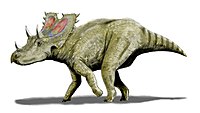         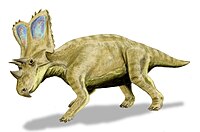    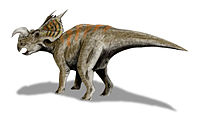        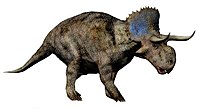    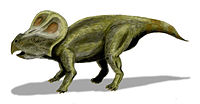       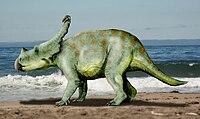   |
|
77 million years ago | Aguja Formation, Texas | A chasmosaurine. | |
|
||||
|
||||
|
||||
|
||||
|
||||
|
||||
|
||||
|
||||
|
||||
|
||||
|
||||
|
||||
|
||||
|
||||
|
||||
|
||||
|
||||
|
||||
|
||||
|
||||
|
||||
|
||||
|
||||
|
||||
|
||||
|
||||
|
||||
|
||||
|
||||
|
Chubut Province, Argentina | A dubious genus of possible ceratopsian affinity | ||
|
||||
|
||||
|
||||
|
||||
|
||||
|
||||
|
||||
|
||||
|
||||
|
||||
|
||||
|
||||
|
||||
|
||||
|
||||
|
72 mya | Coahuila, Aguja Formation, Mexico | A centrosaurine. | |
†Pachycephalosaurs
[edit]| Pachycephalosaurs of the Campanian | ||||
|---|---|---|---|---|
| Taxa | Presence | Location | Description | Images |
| Alberta, Canada | The oldest known pachycephalosaurid. |
         | ||
| Mongolia | ||||
| Alberta, Canada; Montana, USA | Distinguished from other pachycephalosaurs by having a depressed parietal region, wide frontoparietal dome, broad nasal characteristics, reduced prefontal lobes, and a reduced parietosquamosal shelf. | |||
| Mongolia | Sporting a flat, wedge-shaped skull roof, Homalocephale was different from other pachycephalosaurs. | |||
| A possible synonym of [Stegoceras]]. | ||||
| 77 mya | Aguja Formation, Texas | |||
†Ornithopods
[edit]| Ornithopods of the Campanian | ||||
|---|---|---|---|---|
| Taxa | Presence | Location | Description | Images |
| 79 mya | Montana and Utah, USA | A genus of basal saurolophine hadrosaur. |
          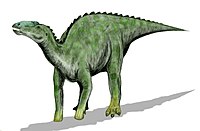     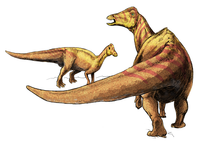          | |
| 76.9 mya | Aguja Formation, Texas | A lambeosaurine. | ||
| Aguja Formation, Texas | Formerly referred to Kritosaurus and Gryposaurus it might be a much more basal hadrosaurid. | |||
| Upper Santonian-Lower Campanian boundary 85.8 mya | Bostobe Formation, Kazakhstan | A basal lambeosaurine hadrosaur, Aralosaurus was about the size of an elephant. Although very little is known about Aralosaurus (only one near complete skull has been found); it was identified by a beak with nearly 1,000 small teeth in 30 rows. The back of an Aralosaurus skull was wide, a feature suggestive of large jaw muscles used to power its chewing apparatus. | ||
| 76.5 mya | Montana, USA; Alberta, Canada | Brachylophosaurus was a basal saurolophine hadrosaur which reached an adult length of 9 meters (30 feet). | ||
| 77-76.5 mya | Alberta, Canada | A derived lambeosaurine. Corythosaurus weighed in at 4 tonnes and measured roughly 10 metres (33 feet) from nose to tail. | ||
| 75 mya | Montana, USA | A dubious genus of hadrosaur known only from dental fossils. | ||
| 73.0-76.5 mya | Canada | Edmontosaurus, a saurolophine hadrosaur, included some of the largest ornithischian species, measuring up to 12 metres (39 feet) long and weighing around 4.0 metric tons (4.4 short tons). | ||
| 85 mya | Argentina | Gasparinisaura was a small ornithopod of the basal clade Elasmaria. In 2010 Gregory S. Paul estimated the length at 1.7 metres, the weight at thirteen kilogrammes. | ||
| 72 mya | Mongolia | A relatively large hadrosauromorph. | ||
| 83-75.5 mya | Alberta, Canada | Gryposaurus was a saurolophine hadrosaur of typical size and shape. | ||
| 79.5 mya | New Jersey, USA | One of the most basal hadrosaurids and the namesake genus of the family. It was likely bipedal for the purposes of running, but could use its forelegs to support itself while feeding. | ||
| 75-67 mya | Alberta, Canada | A derived lambeosaurine, Hypacrosaurus is most easily distinguished from other hollow-crested duckbills by its tall neural spines and the form of its crest. The neural spines, which project from the top of the vertebrae, are 5 to 7 times the height of the body of their respective vertebrae in the back,[4] which would have given it a tall back in profile. The skull's hollow crest is like that of Corythosaurus, but is more pointed along its top, not as tall, wider side to side, and has a small bony point at the rear | ||
| North Carolina and Missouri, USA | A large hadrosauroid known only by a couple of vertebrae. | |||
| 73 mya | North America | The type specimen of Kritosaurus navajovius is only represented by a partial skull and lower jaws, and associated postcranial remains. | ||
| 76-75 mya | Alberta, Canada | A derived lambeosaurine hadrosaur, namesake genus of the subfamily. | ||
| 80 mya | Alabama, USA | A genus of hadrosauromorphs. | ||
| Aguja Formation, Texas | A basal hadrosaur. | |||
| 76.7 mya | Montana, USA | Maiasaura was a large basal saurolophine hadrosaur, attaining an adult length of about 9 metres (30 feet) and had the typical hadrosaurid flat beak and a thick nose. It had a small, spiky crest in front of its eyes. The crest may have been used in headbutting contests between males during the breeding season. | ||
| China | A possibly dubious genus of hadrosaur known by a partial lower jaw from a juvenile. | |||
| Austria | A rhabdodontid. | |||
| 73 mya | New Mexico, USA | Naashoibitosaurus, a saurolophine hadrosaur, based as it is on a single partial skeleton, is not well known in terms of anatomy. Its skull, the most thoroughly described portion, has a low nasal crest that peaks in front of the eyes, but does not strongly arch as in Gryposaurus. | ||
| 80 mya | Sakhalin island | A lambeosaurine hadrosaur known from subadult remains. | ||
| 78 mya | New Mexico, USA | A genus of basal saurolophine hadrosaur. | ||
| 76.5-73 mya | Alberta, Canada; New Mexico and Utah, USA | A large derived lambeosaurine hadrosaur. | ||
| 79 mya | Montana, USA; Alberta, Canada | A large basal saurolophine hadrosaur which reached an adult length of over 9 meters (30 feet). | ||
| 76-75 mya | Alberta, Canada | Prosaurolophus was a large-headed duckbill; the most complete described specimen has a skull around 0.9 meters (3.0 feet) long on a ~8.5 meter long skeleton (~28 ft).[2] It had a small, stout, triangular crest in front of the eyes; the sides of this crest were concave, forming depressions. The upper arm was relatively short. | ||
| 75 mya | Montana, USA | A dubious genus of lambeosaurine hadrosaurs. Historically, several species were assigned to it, all based on extremely fragmentary remains, but there is no evidence to support these assignments. | ||
| 72 mya | France; Spain; Haţeg Island, Romania | It is unclear whether it was an iguanodont or a hypsilophodont, and may be a "missing link" between the two. Current evidence indicates it is an iguanodont similar to Tenontosaurus. | ||
| 69.5-68.5 mya | North America, Asia | Saurolophus is known from material including nearly complete skeletons, giving researchers a clear picture of its bony anatomy. S. osborni, the rarer Albertan species, was around 9.8 meters (32 feet) long, with its skull a meter long (3.3 feet). Its weight is estimated at 1.9 tonnes (2.1 tons). S. angustirostris, the Mongolian species, was larger; the type skeleton is roughly 12 meters (39 feet) long, and larger remains are reported. | ||
| 72 mya | China | A very large saurolophine hadrosaur closely related to Edmontosaurus, it is one of the longest and largest known hadrosaurids and possibly the largest non-sauropod dinosaur; the composite skeleton of a medium-sized individual mounted at the Geological Institute of China in Beijing measures 14.72 metres (48.3 feet) in length. | ||
| 76–75 mya | Dinosaur Park Formation, Alberta | A dubious genus of hadrosaurid dinosaur with a complicated taxonomic history. | ||
| 72–71 mya | China | A genus of hadrosauromorph dinosaur. | ||
| 77 mya | Montana, USA | Trachodon is a dubious genus of hadrosaurid dinosaur based on teeth. Numerous species had been referred to this genus later reassigned to different genera or proven dubious. | ||
| 72 mya | Southern China | A basal but relatively large lambeosaurine hadrosaur. | ||
| 72 mya | Mexico | A large derived lambeosaurine. | ||
†Sauropoda
[edit]| Sauropods of the Campanian | ||||
|---|---|---|---|---|
| Taxa | Presence | Location | Description | Images |
| Southwestern United States | Alamosaurus is a genus of titanosaurian sauropod dinosaur from the Late Cretaceous Period of what is now North America. It was a large quadrupedal herbivore. |
       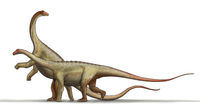 | ||
| Neuquén Province, Argentina | Andesaurus is a genus of basal titanosaurian sauropod dinosaur. | |||
| Lago Colhué Huapi Formation, Argentina | ||||
| Cerro Fortaleza Formation, Argentina | Dreadnoughtus is one of the largest titanosaurs known. | |||
| Adamantina Formation and Cambabe Formation, Brazil | ||||
| North East, China | A member of the Euhelopodidae sauropods. | |||
| Allen Formation and Anacleto Formation, both in Argentina; Palacio Formation, Uruguay | ||||
| Campanian-Maastrichtian | Allen Formation, Argentina | |||
| Santonian-Campanian | Bajo de la Carpa Formation, Argentina | |||
| Anacleto Formation, Argentina | ||||
| Neuquén Province, Argentina | Small-sized titanosaur. | |||
| Shar Tsav, Mongolia | Quaesitosaurus is a genus of titanosaurian sauropod. | |||
| north-west Argentina; Uruguay | Saltasaurus is a genus of titanosaurid sauropod dinosaur. An estimated length of 12 metres (39 feet) and a mass of 7 tonnes (8 tons). | |||
| Campanian-Maastrichtian | Allen Formation, Rio Negro Province, Argentina | |||
Theropoda
[edit]David J. Varrichio observes that during the late Campanian Alberta and Montana had very similar theropods despite significant differences in the types of herbivorous dinosaur faunas.[2]
| Non-avian theropods of the Campanian | ||||
|---|---|---|---|---|
| Taxa | Presence | Location | Description | Images |
| Allen Formation?, Anacleto Formation?, Argentina | An abelisaurid ceratosaur that probably reached 7 to 9 meters in length; known from only one partial skull. |
               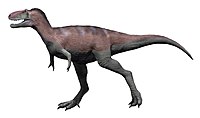   | ||
| A derived tyrannosauroid. | ||||
| An ornithomimid ornithomimosaur. | ||||
| A small dromaeosaurid. | ||||
| A large derived tyrannosauroid. | ||||
| A troodontid | ||||
| An oviraptorid oviraptorosaur. | ||||
| A derived abelisaurid ceratosaur that probably reached 7 to 9 meters in length | ||||
| A caenagnathid oviraptorosaur. | ||||
|
A genus of large and robustly built tyrannosaurines. | |||
| Judith River Formation | A dubious tyrannosaurid known from tooth remains. | |||
| A small to medium sized dromaeosaurid maniraptoran theropod with a sickle-like claw. | ||||
| An ornithomimid ornithomimosaur. | ||||
| A derived tyrannosaur. | ||||
| A large basal tyrannosaurine. | ||||
| A troodontid | ||||
| An albertosaurine tyrannosaurid. | ||||
| A basal ornithomimosaur. | ||||
| An oviraptorid oviraptorosaur. | ||||
|
†Kol |
An alvarezsaurid. | |||
| A large robust theropod of uncertain affinities, possibly a tyrannosaur. | ||||
| A caenagnathid oviraptorosaur. | ||||
| A dromaeosaurid. | ||||
| Wahweap Formation, Utah | A 7-meter tyrannosaurine known from a partially complete skull, some vertebrae and a complete pubis | |||
| A dromaeosaurid. | ||||
| A small unenlagiid maniraptoran. | ||||
| A relatively large-bodied therizinosaurid. | ||||
| A small derived ceratosaur. | ||||
| An ornithomimid ornithomimosaur. | ||||
| Mongolia | Oviraptor is an oviraptorid oviraptorosaur in the subfamily Oviraptorinae. | |||
| An alvarezsaur. | ||||
| Var, France | A small dromaeosaurid. | |||
| A coelurosaur form taxon known only from teeth and lower jaw fragments. | ||||
| A troodontid. | ||||
| A dromaeosaurid. | ||||
| An alvarezsaur. | ||||
| An ornithomimid ornithomimosaur. | ||||
| A basal tyrannosaurine. | ||||
| A close relative of Daspletosaurus. | ||||
| A troodontid. | ||||
| A dromaeosaurid. | ||||
| Var, France | A dromaeosaurid. | |||
| Mongolia and China | A dromaeosaurid. | |||
| Wangshi Group, Zhucheng, China | One of the largest tyrannosaurids at between 10–12 meters. Known from a lower jaw and maxilla slightly smaller than those of the later Tyrannosaurus. | |||
Avialae
[edit]| Birds of the Campanian | ||||
|---|---|---|---|---|
| Taxa | Presence | Location | Description | Images |
| A genus of enantiornithine birds of uncertain affinities. |
 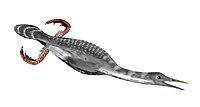  
| |||
| A genus of basal ornithuran birds. | ||||
| A genus of basal ornithuromorph birds. | ||||
| A genus of flightless hesperornithiform birds. | ||||
| A genus of freshwater hesperornithiform birds. Although Hesperornithes probably lost their flight abilities by the end of the Early Cretaceous, minimal pachyostosis in Brodavis suggests the possibility of some volant abilities. | ||||
| A genus of flightless hesperornithid birds. | ||||
| An enantiornithe of uncertain affinities. It was estimated to have a wingspan of around 127–185 cm and may have been 75 to 110 cm long when fully grown, making it one of the largest known enantiornitheans to date. | ||||
| ~85 mya | Bostobe Formation, Kazakhstan | An extinct genus of birds. The type species, C. sarysuensis, is known only from an isolated, asymmetrical contour feather | ||
|
|
Elsornis is a genus of basal enantiornithine birds. It was flightless or nearly so. | |||
| A genus of large, primitive and potentially flightless avialan. | ||||
| An avisaurid enantiornithe, previously thought to be a species of the later closely related Maastrichtian genus Avisaurus. | ||||
| A genus of euenantiornithine enantiornithe. It possessed a robust beak which convergently evolved with those of modern birds. | ||||
| A genus of avisaurid enantiornithe. It lived in a coastal environment. | ||||
| A genus of flightless hesperornithid birds. | ||||
| A genus of small ground birds. It was either an enantiornithe or a basal ornithuromorph. | ||||
| A genus of toothy seabird-like ornithuran. | ||||
| A genus of avisaurid enantiornithe. Although closely related to some of the largest avisaurids, members of this genus were very small birds. | ||||
| A genus of large marine diving vegaviid bird with an estimated body mass of 1.5 kg. | ||||
| A genus of avisaurid enantiornithes, closely related to the later genus Avisaurus. | ||||
| Limenavis is the closest known relative of modern birds. | ||||
| A marine bird from Chile. It had the midfeet of a foot-propelled diving bird, but its relationships are enigmatic. The only known species is from the Campanian-Maastrichtian boundary. | ||||
| A genus of basal long-tailed avialan. May potentially be a non-avialan genus of theropod. | ||||
Mammals
[edit]| Mammals of the Campanian | ||||
|---|---|---|---|---|
| Taxa | Presence | Location | Description | Images |
| A basal metatherian. | ||||
| A basal metatherian. | ||||
| A multituberculate allotherian. | ||||
| An insectivorous leptictid eutherian. | ||||
| Also known as Gobibaatar[3] or Tugrigbaatar[4]. It's a multituberculate allotherian. | ||||
| Type genus of Zalambdalestidae, a basal clade of Asian eutherians. | ||||
